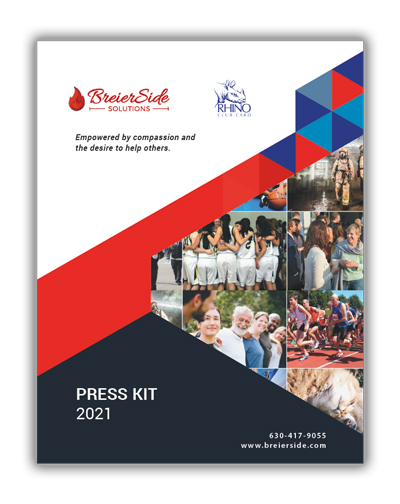Many people have heard of media kits or press kits but they are unsure how to actually make one.
A media kit is an important tool for companies, authors and public relations companies to offer local newspapers, broadcast channels, bloggers, freelance writers, trade media, and reporters in order to tell their story. Reporters, columnists and other content creators regularly use media kits to learn about a news subject from the inside out.
The media kit is designed to make a reporter’s job easier and provide a deep look into a business, organization, project, publication, or leader—all of which can be considered “news subjects” for the reporter to cover. The media kit presents the story that the news subject wants to tell the world. In short, the media kit is the publicist’s tool to get reporters interested in featuring their clients in their stories or using them as a source.
At JJR Marketing, we guide clients in how to make a media kit to make pitching their stories as irresistible as possible to the media. Every media kit is different, depending on the news subject. However, media kits are meant to impress, so they are typically professionally designed, inviting to read, and presented as a multi-page document that is either printed and distributed or put into a pdf format and emailed. Printed versions are often presented in colorful folders, branded with the client’s colors and graphics, or in a bound format with an enticing cover. Use lively photos and other appealing visuals to “wrap” your media kit materials up in an exciting way.
Although there are as many variations as there are media kits in the world, these six elements will most always be found in professionally produced media kits. They make a sturdy foundation for any media kit and we recommend that you include them all in yours, too!
PRESS RELEASES:
The press kit can lead off with the press release for the most current news. Depending on how the press kit is being used, it might be good to show the reader that you have received news coverage before. In those cases, ( i.e., if the media kit is being used for an award nomination) prepare a page of the kit with links to online interviews, podcasts, as well as written material.
FACT SHEET:
The fact sheet provides information about the news subject “at a glance.” The information on the fact sheet will vary, depending on the news subject. However, regardless of the topic, fact sheets are meant to provide quick stats that a reporter can use. For example…
FOR COMPANIES
- Year company was founded
- Executive leader
- Number of employees for companies
- Type of company (private, publicly-held or non-profit)
- Types of services provided
- Service area or number of customers served
- Locations and offices
- Revenue
- Company’s mission/vision statements
- Awards and notable achievements
- Membership in trade organizations
- Full contact information including physical address(es) of headquarters and branches, social media profiles, phone numbers, and pertinent website links
FOR AUTHORS
- ISBN number
- Number of pages
- Year of publication
- Genre
- Contact info for the author, such as personal website and/or social media profiles
- Endorsements
BACKGROUNDER:
This one or two-page piece tells the history of the news subject —how it was founded, how it has grown, and what is planned for the future.
BIOGRAPHIES:
Photos and 100-300 word biographies of the main representatives of the news subject to help reporters plan their interviews and interview your leaders with information about their background.
STORY ANGLES:
Prepare at least three (but preferably five or more) solid and unique story angles for reporters to consider and use, with your news subject as a mention or a source. Reporters not only want to know your story, but how your efforts are reacting to current events, changing market conditions, etc. They want to know how you are solving problems in innovative ways, or what is different about how your news subject is impacting the world. You can also present story angles on your news subject’s community service or good deeds within your industry. Story angles are your chance to present people as thought leaders to the media. Consider anything newsworthy and of human interest within the news subject’s ecosystem to help create an enticing story angle.
QUESTIONNAIRES:
In addition to story angles, another way to make the reporter’s job easier is to provide a list of sample interview questions they can use to interview people concerning your news subject. Try to create at least 5-7 strong questions that would allow the person being interviewed to tell the best parts of their story to the reporter in a natural way.
Beyond these six main items, you can add any other pieces that you think would best represent yourself to the media. Think: if someone had limited time to learn about my company, what information would I absolutely want them to know?
As you’re putting together your media kit you may think to yourself, “Most of this information is on my website. Why am I presenting it again?“ Marie Lazzara, our PR Manager at JJR Marketing, is in charge of creating media kits. She has successfully used them to successfully pitch hundreds of stories to major outlets, trade media, podcasts, and bloggers. We asked her why we need media kits when almost all the information can be found on a website.
“Media kits contain all the information for reporters and editors to have—all in one place. No need for searching,” she said. “Yes, they can get all the information on the web but who has time to do all that? A press kit is a readily available solution.”
Marie also says most of the time JJR Marketing sends media kits out electronically, but she has also distributed printed ones at in-person events as well. The most important parts of a media kit in Marie’s viewpoint? The story angles and the questionnaire.
“Reporters and editors are always looking for experts who can contribute their knowledge to what they are writing or researching,” said Marie. “Story angles can inspire them to create or convince them of your expertise. The questionnaire can save the reporter lots of time in preparing for their interview with the news subject. Never send out a media kit without solid story angles and that questionnaire!”
If you are wondering why our competitors are getting “ink” and you aren’t, it may be because you have not taken time to put together the publicist’s ultimate tool—the media kit. At JJR Marketing, we are experts at finding the story angles within your companies, guiding clients in how to make a media kit and presenting your story to the media to earn you the attention you deserve! If we can help with your public relations or marketing efforts, please contact us to learn more.



